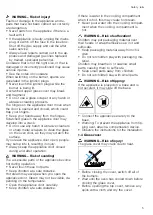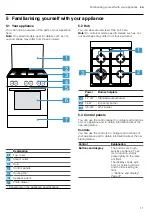
Safety
en
3
Children must not perform cleaning or user
maintenance unless they are at least 15 years
old and are being supervised.
Keep children under the age of 8 years away
from the appliance and power cable.
1.3 Safe use
WARNING ‒ Risk of explosion!
Escaping gas may cause an explosion. WHAT
TO DO IF YOU SMELL GAS OR IF THERE
ARE FAULTS IN THE GAS INSTALLATION
▶
Immediately shut off the gas supply or
close the gas cylinder valve.
▶
Immediately extinguish all naked flames
and cigarettes.
▶
Do not operate any light switches or appli-
ance switches.
▶
Do not pull any plugs out of any sockets.
▶
Do not use any telephones or mobile
phones within the building.
▶
Open windows and ventilate the room.
▶
Call the after sales service or the gas sup-
plier.
Escaping gas may cause an explosion. Small
amounts of gas can collect over a longer
period of time and ignite.
▶
Close the safety valve for the gas supply
when the appliance is out of use for pro-
longed periods.
Escaping gas may cause an explosion. If the
liquefied gas bottle is not upright, liquefied
propane/butane can enter the appliance. In-
tense darting flames may therefore escape
from the burners. Components may become
damaged and start to leak over time so that
gas escapes uncontrollably.
▶
Always use liquefied gas bottles in an up-
right position.
Escaping gas may cause an explosion. If the
gas pressure in your distributing pipes is
more than 20% higher than the values spe-
cified on the appliance's rating plate, a gas
leak can occur.
▶
For your own safety, it is imperative that
you operate the appliance with a suitable
gas governor.
▶
If you do not know what the gas pressure
in your gas distributing pipes is, please ask
your local gas company.
▶
Connection, maintenance and setting of the
gas governor must be carried out by an au-
thorised installation specialist.
WARNING ‒ Risk of suffocation!
Using the gas cooking appliance leads to a
build-up of heat, moisture and combustion
products in the room where the appliance is
installed.
▶
Ensure that the kitchen is sufficiently ventil-
ated, in particular when operating the gas
cooking appliance.
▶
If the appliance is used intensively and for
prolonged periods, ensure that there is ad-
ditional ventilation so that the combustion
products are safely fed to the outside, e.g.
if using existing ventilation equipment, set a
higher performance level and, at the same
time, ensure that the air is replaced with
fresh air in the room where the appliance is
installed.
▶
Consult specialist personnel when installing
additional ventilation equipment.
WARNING ‒ Risk of fire!
The appliance will become hot.
▶
Do not keep combustible objects or aero-
sol cans in drawers directly underneath the
hob.
▶
Never store or use combustible materials
(e.g. spray cans or cleaning agents) under
the appliance or in its immediate vicinity.
The cooking surface becomes very hot.
▶
Never place flammable objects on the
cooking surface or in its immediate vicinity.
▶
Never place objects on the cooking sur-
face.
Leaving fat or oil cooking on an unattended
hob can be dangerous and may lead to fires.
▶
Never leave hot oil or fat unattended.
▶
Never attempt to extinguish a fire using wa-
ter; instead, switch off the appliance and
then cover with a lid or a fire blanket.
Hob covers can cause accidents, for example
due to overheating, catching fire or materials
shattering.
▶
Do not use hob covers.
The appliance becomes very hot, fabrics and
other objects may ignite.
▶
Keep fabrics (e.g. garments or curtains)
away from the flames.
▶
Never reach over the flames.
▶
Do not place combustible objects (e.g. tea
towels or newspapers) on, next to or be-
hind the appliance.
Opening the appliance door creates a
draught. Greaseproof paper may come into




































